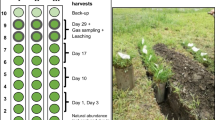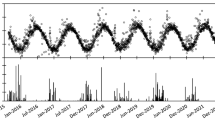Abstract.
Field experiments were carried out over a 2-year period on a loamy soil plot under corn in Montpellier (south-east France). The effectiveness of improved irrigation practices in reducing the adverse impact of irrigation on the environment was assessed. Different irrigation and fertiliser treatments were applied to identify the best irrigation and fertilisation strategy for each technique (furrow and sprinkler) to ensure both good yields and lower NO3 – leaching. No significant differences in corn yield and NO3 – leaching were found for the climatic scenario of 1999 between sprinkler and furrow irrigation during the irrigation season. Following the rainy events occurring after plant maturity (and the irrigation season), differences in N leaching were observed between the treatments. The study shows that both the fertiliser method, consisting of applying a fertiliser just before ridging the furrows, and the two-dimensional (2D) infiltration process, greatly influence the N distribution in the soil. N distribution seems to have a beneficial impact on both yield and N leaching under heavy irrigation rates during the cropping season. But, under rainy events (particularly those occurring after harvesting), the N, stored in the upper part of the ridge and not previously taken up by plants, can be released into the deeper soil layers in a furrow-irrigated plot. In contrast, the 1D infiltration process occurring during sprinkler irrigation events affects the entire soil surface in the same way. As a result the same irrigation rate would probably increase N leaching under sprinkler irrigation to a greater extent than under furrow-irrigation during an irrigation period. In order to assess the robustness of these interpretations derived from soil N-profile analysis, a modelling approach was used to test the irrigation and fertilisation strategies under heavy irrigation rates such as those occurring at the downstream part of closed-end furrows. The RAIEOPT and STICS models were used to simulate water application depths, crop yield and NO3 – leaching on three measurement sites located along the central furrow of each treatment. The use of a 2D water- and solute-transport model such as HYDRUS-2D enabled us to strengthen the conclusions derived from the observations made on the N distribution under a cross-section of furrow. This model helped to illustrate the risk of over-estimation of N leaching when using a simplified 1D solute-transport model such as STICS.
Similar content being viewed by others
Author information
Authors and Affiliations
Additional information
Electronic Publication
Rights and permissions
About this article
Cite this article
Mailhol, .J., Ruelle, .P. & Nemeth, .I. Impact of fertilisation practices on nitrogen leaching under irrigation. Irrig Sci 20, 139–147 (2001). https://doi.org/10.1007/s002710100038
Received:
Issue Date:
DOI: https://doi.org/10.1007/s002710100038




